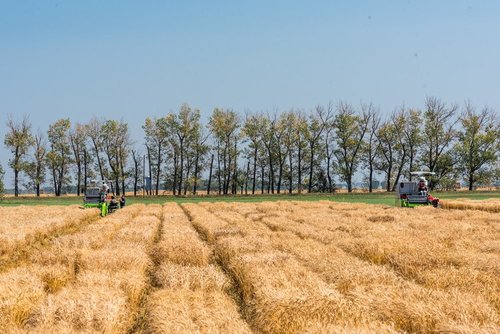Offering Strong Options for Canada Western Red Spring (CWRS) Wheat in the Western Prairies
Written by: Michelle Boulton
Looking at the 2022 numbers for insured commercial acres of Canadian Western Red Spring (CWRS) wheat, Richard Cuthbert can’t help being confident his research program is offering producers excellent varieties. Cuthbert is a wheat breeder with Agriculture and Agri-Food Canada’s Swift Current Research Development Centre. He points out that 8 of the top 10 CWRS varieties were developed by his group with support from the Canadian Wheat Research Coalition.
Reflecting on the current funding cycle, he says two of the most notable are AAC Wheatland and AAC Starbuck. Registered in 2018, these two were available to farmers last year and have already seen strong uptake.
“AAC Starbuck (at 9%) would be the third most popular; AAC Wheatland (at 8%) would be the fourth most popular. Together, they feature about 1.1 million insured acres in their first year of commercialization,” he says.
Both are semi-dwarf CWRS varieties with excellent grain yield, high protein, good straw strength, and tolerance to orange wheat blossom midge. AAC Starbuck also provides fewer fusarium head blight (FHB) symptoms and lower deoxynivalenol accumulation in the grain.
More recently, AAC Hockley was approved for registration, but is not yet available to farmers. It’s not midge-resistant, but has an excellent disease resistance package, including best-in-class FHB resistance. Cuthbert says it performed significantly better than the check (AAC Brandon) in variety trials this year.
“It’s finding a following all over the prairies, but specifically in irrigation areas because it is very strong strawed and has such good FHB and stripe rust resistance,” he says.
According to Cuthbert, Canada’s registration system promotes the advancement of adaptable varieties. “It takes up to three years in trials to achieve a support package to present to the committee,” he explains. “Typically, with at least 12 sites per year, you’ll see lines that have very strong adaptation across a range of environments and growing regions.” He credits the registration system for the high uptake in his program’s varieties.
“We can’t predict what the environment will be in any given year, so it’s hard to tailor a variety to that,” he says. Instead, “we try to build in as much genetic resistance as we can to prevent prevalent diseases without having to use chemical inputs for control. A large part of our research breeding is reducing the business risk for farmers and processors.”
He anticipates proposing four CWRS lines for registration this winter: three are bred for drought and heat stress, and one is a solid stem variety that looks promising. Two (BW5089 and BW5090) are non-midge resistant, showing very strong yield and excellent disease resistance to all priority one diseases and loose smut. There’s one (BW5095) with midge resistance that’s very high yielding and has a very good disease package.
He says the solid-stem line (BW5104) “is a little early to bring forward for registration but, given the recent challenges with wheat stem sawfly in the brown soil zone, the industry needs a new CWRS variety to provide control against this devastating pest.” They have 22 sites of data and require 24 sites to propose the line for registration, so they plan to keep this line in registration trials for one more year to confirm performance and end-use quality.
These will be the final outputs from this round of funding, which came from Alberta Wheat Commission, Saskatchewan Wheat Development Commission, Manitoba Crop Alliance, and Western Grains Research Foundation.









